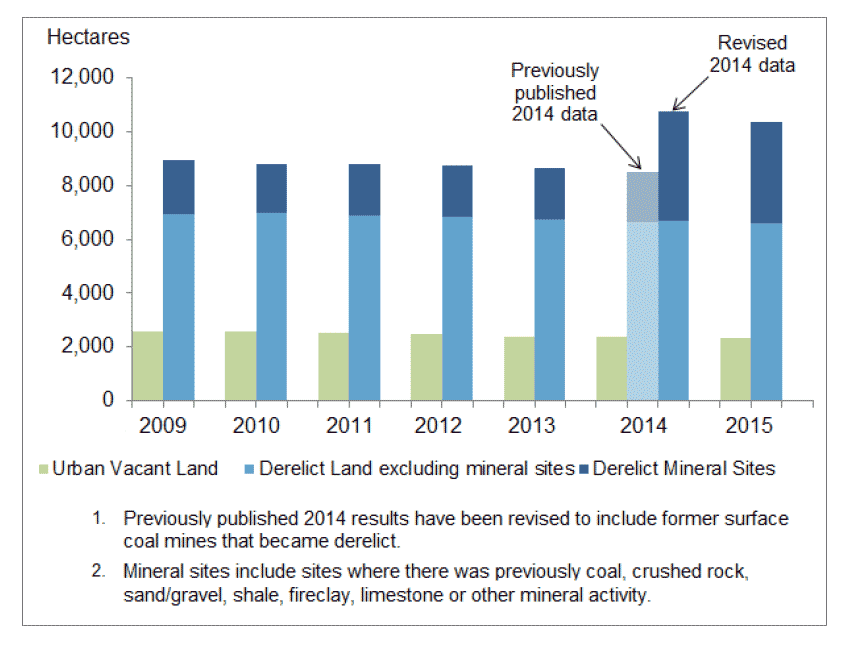Scottish Vacant and Derelict Land Survey 2015
The Scottish Vacant and Derelict Land Survey is a data collection undertaken to establish the extent and state of vacant and derelict land in Scotland. The survey has been operating since 1988, and is managed by the Scottish Government Communities Analysi
1 Background to the survey
1.1 The Scottish Vacant and Derelict Land Survey ( SVDLS) is a data collection undertaken to establish the extent and state of vacant and derelict land in Scotland. The survey has been operating since 1988, and is managed by the Scottish Government Communities Analysis Division. The data is sourced from local authorities and the Loch Lomond and Trossachs National Park Authority. Most authorities submit data annually with a Survey base date of 31st March. This bulletin presents a summary of the results.
Chart 1: Total Derelict and Urban Vacant Land, 2009-2015 1,2

1.2 Results for 2014 have been revised based on the latest data received to incorporate areas of former surface coal mine sites in East Ayrshire which became derelict following the liquidation of Scottish Coal and ATH Resources in 2013. This has led to an upward revision of 2,217 hectares in the total amount of derelict land in 2014. Along with some other smaller revisions this has increased the total amount of derelict land in 2014 from 8,509 hectares to 10,753 hectares. The revised results now show that the total amount of derelict land increased by 2,108 hectares (24.4%) between 2013 and 2014, from 8,645 hectares to 10,753 hectares. There has been a reduction in the total amount of derelict land between 2014 to 2015 from 10,753 hectares to 10,365 hectares. This is mainly due to the reduction recorded in the size of the former Westfield opencast site near Kinglassie in Fife, from 305 hectares to 97 hectares.
1.3 Excel versions of tables are available on the Planning Statistics webpages, along with a site-level dataset and selected maps and charts. These are published at: http://www.gov.scot/Topics/Statistics/Browse/Planning/Publications
1.4 The main purpose of these statistics is to provide the evidence base for monitoring the extent and state of urban vacant and derelict land, the remediation of vacant and derelict land and progress in bringing it into re-use, and to inform the programming of rehabilitation, planning and reuse of urban vacant and derelict sites. The statistics are used by the Scottish Government to help allocate and monitor the impact of the Vacant and Derelict Land Fund ( VDLF). The VDLF is one of three elements of the Capital Investment Fund, which supports physical development and focuses on key regeneration interventions. The statistics contribute to the Government's performance indicator for sustainable communities that measures progress on Housing and Regeneration outcomes. Further information on this can be found at:
http://www.gov.scot/Topics/Built-Environment/Housing/reform/HARO/Indicators. Other uses of the statistics by Scottish Government and other stakeholders are published at: http://www.gov.scot/Topics/Statistics/Browse/Planning/DataUses
1.5 In 2015, all 33 authorities submitted survey data. Annex Table E records local authority annual participation in the survey each year since 1996.
1.6 During the collection of the 2015 survey data, a number of revisions to previous year's data have been identified. In particular, for 2014 an addditional 2,217 hectares of derelict land in East Ayrshire, that were previously surface coal mines have been added retrospectively. Some previous survey returns for the years 2009 to 2014 have been revised to remove sites that have been taken out of the survey for definitional reasons (for example, when new information comes to light such as a presumption about ground contaminants from a previous use has been shown to be incorrect and so the site no longer meets the criteria for vacant or derelict land). There were a total of 52 sites (320 hectares) split/amalgamated, naturalised or removed for definitional reasons in the 2015 survey. The majority of this area (217 hectares) was removed from the former Westfield opencast site near Kinglassie in Fife. In addition, some previous survey returns have also been revised to incorporate updates to underlying data. This revisions process is carried out so that any time series analysis presented within this bulletin is as accurate as possible. The revision to 2014 data to include the former surface coal mines that were in East Ayrshire as well as revisions for other Local Authorities gives an increase at Scotland level of 21% (2,257 hectares) compared to the prevously published figure. At Scotland level, apart from the big increase in 2014, differences between the revised data and the previous versions have been at most 0.4% (39 hectares) for any particular year. Further information is available in section A4 of the Annex, along with unrevised historical data for 1996 to 2008.
1.7 Vacant land is land which is unused for the purposes for which it is held and is viewed as an appropriate site for development. This land must either have had prior development on it or preparatory work has taken place in anticipation of future development.
1.8 The main part of this bulletin covers vacant land (referred to as Urban Vacant) that is located within settlements of over 2,000 in population (as defined in council local plans, see Annex Section A.6). Some local authorities have also surveyed for vacant land within settlements of under 2,000 in population. Further information on those results can be found in Annex Table B.
1.9 Derelict land (and buildings) is land which has been so damaged by development, that it is incapable of development for beneficial use without rehabilitation. In addition the land must currently not be used for the purpose for which it is held or a use acceptable in the local plan. Land also qualifies as derelict if it has an un-remedied previous use which could constrain future development. For both vacant and derelict land, site records must be at least 0.1 hectares in size to be included.
Contact
There is a problem
Thanks for your feedback